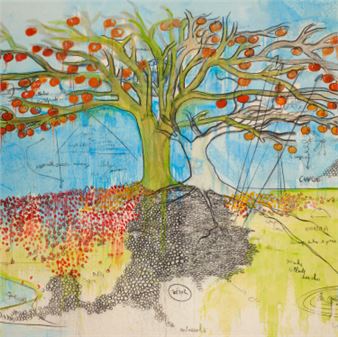Thilo Heinzmann
A white square picture plane above which a pigment explosion has taken place. If we described the German artist Thilo HeinzmannŌĆÖs painting in one sentence, this is how it looks like at first sight. When Robert Rauschenberg painted his canvas entirely white in 1951, he famously said that the white painting was the runway for light and shadow. In a parallel comparison, HeinzmannŌĆÖs series of paintings on white canvases with dashes of pigment could be defined as runways for bursts of color. The micro-dust of color dancing in the air eventually lands on the canvas and sticks to its surface, leaving us viewers wondering what it is we are seeing and how it is made ŌĆ”
For the past several decades Thilo Heinzmann has been creating paintings that visually challenge the viewers and conceptually question the nature and raison dŌĆÖetre of this ancient art form in our contemporary society. An unaccomplished mission in which his contemporaries have investigated and experimented in paintingŌĆÖs expanded fields. HeinzmannŌĆÖs professor, Thomas Bayrle, contributed by reinterpreting patterned images from mass-media sources to create repeating rhythms on flat surfaces; and Martin Kippenberger, whom Heinzmann assisted during his time at the St├żdelschule in Frankfurt, both mocked and enchanted the mediumŌĆÖs resurgence.

Recommended for you
A white square picture plane above which a pigment explosion has taken place. If we described the German artist Thilo HeinzmannŌĆÖs painting in one sentence, this is how it looks like at first sight. When Robert Rauschenberg painted his canvas entirely white in 1951, he famously said that the white painting was the runway for light and shadow. In a parallel comparison, HeinzmannŌĆÖs series of paintings on white canvases with dashes of pigment could be defined as runways for bursts of color. The micro-dust of color dancing in the air eventually lands on the canvas and sticks to its surface, leaving us viewers wondering what it is we are seeing and how it is made ŌĆ”
For the past several decades Thilo Heinzmann has been creating paintings that visually challenge the viewers and conceptually question the nature and raison dŌĆÖetre of this ancient art form in our contemporary society. An unaccomplished mission in which his contemporaries have investigated and experimented in paintingŌĆÖs expanded fields. HeinzmannŌĆÖs professor, Thomas Bayrle, contributed by reinterpreting patterned images from mass-media sources to create repeating rhythms on flat surfaces; and Martin Kippenberger, whom Heinzmann assisted during his time at the St├żdelschule in Frankfurt, both mocked and enchanted the mediumŌĆÖs resurgence.
Artists on show
Contact details
















